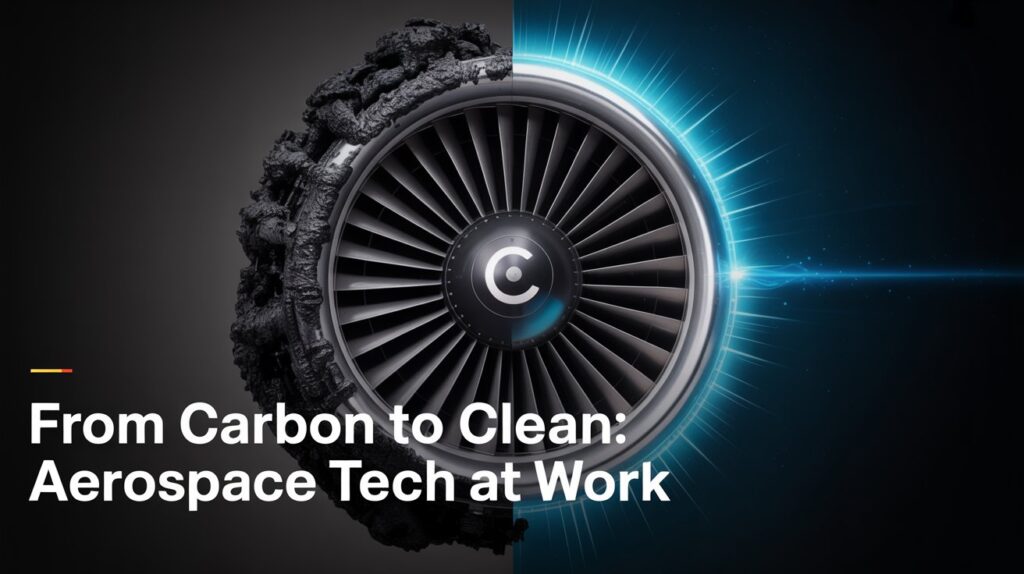In the world of aerospace, performance isn’t just about speed or design; it’s about reliability. Every component in an aircraft, from the turbine blades to hydraulic lines, must perform flawlessly under extreme conditions. Yet over time, engines and systems accumulate carbon deposits and other stubborn residues that can quietly undermine efficiency and safety. For decades, maintenance crews relied on labor-intensive methods and harsh chemicals to keep components clean. Today, however, advanced cleaning technologies from Ohana Chem Co. are redefining what “maintenance-ready” truly means, transforming how the industry keeps its fleets flying clean and strong.
The Hidden Cost of Carbon Buildup
When jet engines operate at high temperatures, the byproduct is inevitable: carbon buildup. These dark, stubborn deposits cling to metal surfaces, valves, and intricate channels where even a small amount can alter performance. Over time, carbon residues increase engine drag, reduce fuel efficiency, and interfere with heat transfer. For maintenance teams, removing these deposits has always been a demanding and delicate process. Scrubbing, soaking, or blasting often risked damaging parts or required extended downtime, both costly and inefficient for airlines, as every hour of maintenance translates to lost operational time.
Traditional cleaning agents, while powerful, brought their own challenges. Many were highly corrosive, emitting fumes that posed health risks to technicians and requiring special handling or disposal. The industry faced a critical question: how to achieve deeper, safer cleaning without compromising the integrity of sensitive aerospace components?
Technology Takes Flight in the Art of Cleaning Science
The turning point came with the rise of precision cleaning technologies explicitly designed for aerospace materials and geometries. These innovations combined chemistry, material science, and process control to achieve something previously out of reach: molecular-level cleanliness.
Modern cleaning solutions now use advanced surfactant and solvent systems that penetrate micro-contours of turbine components, dissolving carbon and varnish residues from even the tightest internal pathways. Unlike aggressive acids or caustics, these formulations are engineered to lift contaminants without etching or weakening alloys. The result is a cleaner surface that restores thermal efficiency and extends component life, all while improving worker safety and environmental compliance.
Some systems also integrate ultrasonic or aqueous cleaning methods, which use microscopic vibrations and water-based solutions to dislodge residues that manual methods simply can’t reach. This level of precision is essential for complex assemblies like fuel nozzles or hydraulic actuators, where microscopic contamination can disrupt flow and pressure balance.
The Power of Smart Chemistry
What makes the new generation of cleaning solutions so effective isn’t just what they remove, but how they remove it. The chemistry behind these formulations has evolved to selectively break down carbon chains, oils, and polymers while leaving base materials untouched. This balance allows aerospace technicians to achieve consistent results without extensive rework or inspection delays.
An example of such innovation can be found in industrial-grade solutions like CDA 12a. This unique compound was developed to address the toughest residues found in turbine engines and hydraulic systems. Its design demonstrates how smart chemistry can deliver powerful cleaning action while maintaining material compatibility and minimizing environmental impact. In practical terms, this means faster turnaround times, reduced labor, and fewer maintenance cycles; all crucial for improving fleet reliability and operational efficiency.
Redefining Efficiency and Safety
Efficiency in aerospace maintenance isn’t just about working faster; it’s about doing the job right every single time. With the help of advanced cleaning technologies from companies like Ohana Chem Co., technicians can now rely on steady, repeatable processes that produce consistent results. Instead of relying solely on manual skill, maintenance teams use controlled cleaning systems to ensure every part is spotless and ready before reassembly.
This level of precision directly affects flight safety. Even the smallest trace of residue in fuel or hydraulic systems can cause pressure drops, temperature spikes, or even part failure when under stress. Modern cleaning solutions eliminate these risks at the molecular level, keeping engines running smoothly, reducing the chance of maintenance-related issues, and allowing aircraft to go longer between major overhauls.
Equally important is the industry’s move toward safer, more sustainable practices. New biodegradable and non-toxic cleaning agents are replacing harsh solvents that once demanded heavy ventilation and special disposal procedures. The result is a cleaner, safer workspace for technicians and a smaller environmental footprint for the entire aerospace industry.
Extending the Lifespan of Aerospace Assets
Cleanliness is more than an aesthetic goal; it’s a key factor in extending component longevity. Every residue removed from a turbine blade or hydraulic valve prevents potential corrosion or thermal degradation down the line. Over the lifecycle of an aircraft, the cumulative effect of advanced cleaning translates to fewer replacements, lower operating costs, and sustained peak performance.
By integrating these technologies into routine maintenance cycles, operators are no longer just reacting to wear and tear; they’re proactively preserving mechanical health. Combined with predictive maintenance data and inspection analytics, the next phase of aerospace care is becoming more preventive than corrective.
Final Thoughts
Aerospace maintenance has come a long way from the days of manual scrubbing and harsh solvent baths. Today, advanced chemical technologies clean at the molecular level, delivering not just spotless results but also safer and more sustainable performance. As aircraft continue to push the limits of endurance and efficiency, even the smallest breakthroughs in cleaning technology can significantly impact safety, reliability, and environmental responsibility. This demonstrates how chemistry and engineering now work together to keep the skies cleaner and the engines performing at their best.

